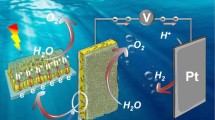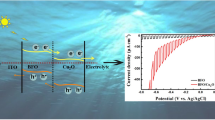Abstract
To drive photoelectrochemical water splitting on porous BiVO4 photoanode, we herein prepared a carnation-like CuS powder by hydrothermal method and then loaded it onto BiVO4 photoelectrode. Expectedly, the CuS/BiVO4 composite not only presents a higher photocurrent response value at 1.23 V versus RHE (reversible hydrogen electrode) than pure BiVO4 electrode under visible light irradiation, but also exhibits an excellent photoelectrochemical hydrogen production activity in comparison with either the BiVO4 or the CuS. The high ameliorated performance of CuS/BiVO4 composite may be due to the strong absorption of visible light and an effective abatement in combination of carriers. These results demonstrate an effective potential approach to design and construct efficient photoelectrochemical (PEC) systems.











Similar content being viewed by others
References
Suzuki TM, Saeki S, Sekizawa K, Kitazumi K, Takahashi N, Morikawa T. Photoelectrochemical hydrogen production by water splitting over dual-functionally modified oxide: p-type N-doped Ta2O5 photocathode active under visible light irradiation. Appl Catal B. 2017;202:597.
Gao H, Yue HH, Qi F, Yu B, Zhang WL, Chen YF. Few-layered ReS2 nanosheets grown on graphene as electrocatalyst for hydrogen evolution reaction. Rare Met. 2018;37(12):014.
Sun L, Wu Z, Xiang S, Yu J, Wang Y, Lin C, Lin Z. High-efficiency photoelectrochemical hydrogen generation enabled by p-type semiconductor nanoparticle-decorated n-type nanotube arrays. RSC Adv. 2017;7(28):17551.
Veeramani V, Yu H, Hu S, Liu R. Highly efficient photoelectrochemical hydrogen generation reaction using tungsten phosphosulfide nanosheets. ACS Appl Mater Interfaces. 2018;10(20):17280.
Dong Z, Ding D, Li T, Ning C. Facile fabrication of Si-doped TiO2 nanotubes photoanode for enhanced photoelectrochemical hydrogen generation. Appl Surf Sci. 2018;436:125.
Liu Q, Shen J, Yang X, Zhang T, Tang H. 3D reduced graphene oxide aerogel-mediated Z-scheme photocatalytic system for highly efficient solar-driven water oxidation and removal of antibiotics. Appl Catal B. 2018;232:62.
Yang X, Tian L, Zhao X, Tang H, Liu Q, Li G. Interfacial optimization of g-C3N4-based Z-scheme heterojunction toward synergistic enhancement of solar-driven photocatalytic oxygen evolution. Appl Catal B. 2019;244:240.
Cho IS, Chen Z, Forman AJ, Kim DR, Rao PM, Jaramillo TF, Zheng X. Branched TiO2 nanorods for photoelectrochemical hydrogen production. Nano Lett. 2011;11(11):4978.
Cheng C, Karuturi SK, Liu L, Liu J, Li H, Su LT, Tok AI, Fan HJ. Quantum-dot-sensitized TiO2 inverse opals for photoelectrochemical hydrogen generation. Small. 2012;8(1):37.
Pan J, Dong Z, Wang B, Jiang Z, Zhao C, Wang J, Song C, Zheng Y, Li C. The enhancement of photocatalytic hydrogen production via Ti3+ self-doping black TiO2/g-C3N4 hollow core-shell nano-heterojunction. Appl Catal B. 2019;242:93.
Morita K, Takijiri K, Sakai K, Ozawa H. A platinum porphyrin modified TiO2 electrode for photoelectrochemical hydrogen production from neutral water driven by the conduction band edge potential of TiO2. Dalton Trans. 2017;46(44):15181.
Wang L, Duan S, Jin P, She H, Huang J, Lei Z, Zhang T, Wang Q. Anchored Cu(II) tetra(4-carboxylphenyl)porphyrin to P25 (TiO2) for efficient photocatalytic ability in CO2 reduction. Appl Catal B. 2018;239:599.
She H, Zhou H, Li L, Zhao Z, Jiang M, Huang J, Wang L, Wang Q. Construction of a two-dimensional composite derived from TiO2 and SnS2 for enhanced photocatalytic reduction of CO2 into CH4. ACS Sustainable Chemistry & Engineering. 2019;7:650.
Chakrapani V, Thangala J, Sunkara MK. WO3 and W2N nanowire arrays for photoelectrochemical hydrogen production. Int J Hydrogen Energy. 2009;34(22):9050.
Fuku K, Miyase Y, Miseki Y, Funaki T, Gunji T, Sayama K. Photoelectrochemical hydrogen peroxide production from water on a WO3/BiVO4 photoanode and from O2 on an Au cathode without external bias. Chem Asian J. 2017;12:1111.
Zhang R, Ning F, Xu S, Zhou L, Shao M, Wei M. Oxygen vacancy engineering of WO3 toward largely enhanced photoelectrochemical water splitting. Electrochim Acta. 2018;274:217.
Tahir AA, Wijayantha KGU, Saremi-Yarahmadi S, Mazhar M, McKee V. Nanostructured α-Fe2O3 thin films for photoelectrochemical hydrogen generation. Chem Mater. 2009;21(16):3763.
Chemelewski WD, Hahn NT, Mullins CB. Effect of Si doping and porosity on hematite’s (α-Fe2O3) photoelectrochemical water oxidation performance. J Phys Chem C. 2012;116(8):5255.
Liao A, He H, Fan Z, Xu G, Li L, Chen J, Han Q, Chen X, Zhou Y, Zou Z. Facile room-temperature surface modification of unprecedented FeB co-catalysts on Fe2O3 nanorod photoanodes for high photoelectrochemical performance. J Catal. 2017;352:114.
Zhang P, Yu L, Lou XWD. Construction of heterostructured Fe2O3-TiO2 microdumbbells for photoelectrochemical water oxidation. Angew Chem Int Ed. 2018;57:15296.
Ng YH, Iwase A, Kudo A, Amal R. Reducing graphene oxide on a visible-light BiVO4 photocatalyst for an enhanced photoelectrochemical water splitting. J Phys Chem Lett. 2010;1(17):2607.
Yang J, Wu J. Low-potential driven fully-depleted BiVO4/ZnO heterojunction nanodendrite array photoanodes for photoelectrochemical water splitting. Nano Energy. 2017;32:232.
Wang S, He T, Yun J-H, Hu Y, Xiao M, Du A, Wang L. New iron-cobalt oxide catalysts promoting BiVO4 films for photoelectrochemical water splitting. Adv Func Mater. 2018;28:1802685.
Wang M, Wang Q, Guo P, Jiao Z. In situ fabrication of nanoporous BiVO4/Bi2S3 nanosheets for enhanced photoelectrochemical water splitting. Journal of Colloid Interface Science. 2019;534:238.
Shi X, Choi IY, Zhang K, Kwon J, Kim DY, Lee JK, Oh SH, Kim JK, Park JH. Efficient photoelectrochemical hydrogen production from bismuth vanadate-decorated tungsten trioxide helix nanostructures. Nat Commun. 2014;5:5775.
Wang Q, Niu T, Wang L, Huang J, She H. NiFe layered double-hydroxide nanoparticles for efficiently enhancing performance of BiVO4 photoanode in photoelectrochemical water splitting. Chin J Catal. 2018;39(4):613.
Jo WJ, Jang JW, Kong KJ, Kang HJ, Kim JY, Jun H, Parmar KP, Lee JS. Phosphate doping into monoclinic BiVO4 for enhanced photoelectrochemical water oxidation activity. Angew Chem Int Ed. 2012;51:3147.
She H, Sun Y, Li S, Huang J, Wang L, Zhu G, Wang Q. Synthesis of non-noble metal nickel doped sulfide solid solution for improved photocatalytic performance. Appl Catal B. 2019;245:439.
Singh S, Sharma R, Mehta BR. Enhanced surface area, high Zn interstitial defects and band gap reduction in N-doped ZnO nanosheets coupled with BiVO4 leads to improved photocatalytic performance. Appl Surf Sci. 2017;411(31):321.
Wang Q, He J, Shi Y, Zhang S, Niu T, She H, Bi Y. Designing non-noble/semiconductor Bi/BiVO4 photoelectrode for the enhanced photoelectrochemical performance. Chem Eng J. 2017;326:412.
Yang J, Ma S, Liu K, Liang Q, Wang J, Mao C. Preparation and properties of ZrH2/W/B4C/Al composite. Chin J Rare Metals. 2018;42(12):1267.
Wang Q, Niu T, Wang L, Yan C, Huang J, He J, She H, Su B, Bi Y. FeF2/BiVO4 heterojuction photoelectrodes and evaluation of its photoelectrochemical performance for water splitting. Chem Eng J. 2018;337:506.
Wang Q, He J, Shi Y, Zhang S, Niu T, She H, Bi Y, Lei Z. Synthesis of MFe2O4 (M = Ni, Co)/BiVO4 film for photolectrochemical hydrogen production activity. Appl Catal B. 2017;214:159.
Liu C, Li J, Li Y, Li W, Yang Y, Chen Q. Epitaxial growth of Bi2S3 nanowires on BiVO4 nanostructures for enhancing photoelectrochemical performance. RSC Adv. 2015;5:71692.
Hu X, Shen Y, Xu L, Wang L, Lu L, Zhang Y. Preparation of flower-like CuS by solvothermal method for photocatalytic, UV protection and EMI shielding applications. Appl Surf Sci. 2016;385:162.
Wang Q, An N, Bai Y, Hang H, Li J, Lu X, Liu Y, Wang F, Li Z, Lei Z. High photocatalytic hydrogen production from methanol aqueous solution using the photocatalysts CuS/TiO2. Int J Hydrogen Energy. 2013;38(25):10739.
An L, Huang L, Zhou P, Yin J, Liu H, Xi P. A self-standing high-performance hydrogen evolution electrode with nanostructured NiCo2O4/CuS heterostructures. Adv Func Mater. 2015;25(45):6814.
Lu YY, Zhang YY, Zhang J, Shi Y, Li Z, Feng ZC, Li C. In situ loading of CuS nanoflowers on rutile TiO2 surface and their improved photocatalytic performance. Appl Surf Sci. 2016;370:313.
Wang Q, Shi Y, Pu L, Ta Y, He J, Zhang S, Zhong J, Li J, Su B. Fabrication of the carnation-like CCN-CuS p–n heterojunctions with enhanced photocatalytic performance under visible light irradiation. Appl Surf Sci. 2016;367:163.
Kim JH, Jang JW, Kang HJ, Magesh G, Kim JY, Kim JH, Lee J, Lee JS. Palladium oxide as a novel oxygen evolution catalyst on BiVO4 photoanode for photoelectrochemical water splitting. J Catal. 2014;317:126.
Lai C, Zhang M, Li B, Huang D, Zeng G, Qin L, Liu X, Yi H, Cheng M, Li L, Chen Z, Chen L. Fabrication of CuS/BiVO4 (040) binary heterojunction photocatalysts with enhanced photocatalytic activity for Ciprofloxacin degradation and mechanism insight. Chem Eng J. 2019;358:900.
Rao PM, Cai L, Liu C, Cho IS, Lee CH, Weisse JM, Yang P, Zheng X. Simultaneously efficient light absorption and charge separation in WO3/BiVO4 core/shell nanowire photoanode for photoelectrochemical water oxidation. Nano Lett. 2014;14:1099.
Reddy CV, Shim J, Cho M. Synthesis, structural, optical and photocatalytic properties of CdS/ZnS core/shell nanoparticles. J Phys Chem Solids. 2017;103:213.
Pareek A, Dom R, Borse PH. Fabrication of large area nanorod like structured CdS photoanode for solar H2 generation using spray pyrolysis technique. Int J Hydrogen Energy. 2013;38(1):36.
Acknowledgements
This work was financially supported by the National Natural Science Foundation of China (Nos. 21663027 and 21808189), the Natural Science Foundation of Gansu Province (No. 18JR3RA090) and the Opening Project of Key Laboratory of Green Catalysis of Sichuan Institutes of High Education (No. LYJ18205).
Author information
Authors and Affiliations
Corresponding author
Rights and permissions
About this article
Cite this article
Li, Y., Yang, Y., Huang, JW. et al. Preparation of CuS/BiVO4 thin film and its efficacious photoelectrochemical performance in hydrogen generation. Rare Met. 38, 428–436 (2019). https://doi.org/10.1007/s12598-019-01224-3
Received:
Revised:
Accepted:
Published:
Issue Date:
DOI: https://doi.org/10.1007/s12598-019-01224-3




